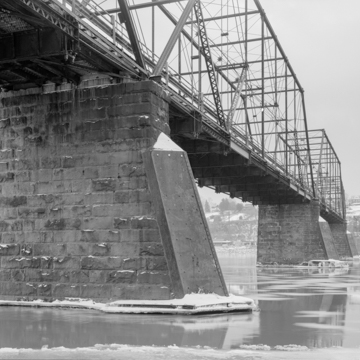The Susquehanna was first bridged at Harrisburg in 1817 by Theodore Burr's “Camelback Bridge,” a wooden truss, covered bridge (demolished) that crossed the mile of river on multiple piers. Presently Harrisburg is the site of numerous bridges of note including the early-twentieth-century Mulberry Street Bridge, designed by James Fuertes and still one of the largest concrete bridges in the nation. The Market Street Bridge is the most important of the city bridges, a long-span structure of sixteen barrel arches that was designed in 1926 by Modjeski and Masters, with consulting architect Paul Cret, bringing together the team that designed the Benjamin Franklin Bridge in Philadelphia ( PH1). The bridge is ornamented with plaques by Alexander Sterling Calder as well as two Ionic columns rescued from the original 1816 capitol. Also of note is the Walnut Street Bridge (1890), a light steel Bollman truss bridge designed by Wendell Bollman of the Phoenix Bridge Company (of Phoenixville); it now provides pedestrian access to City Island.
You are here
Susquehanna River Bridges
If SAH Archipedia has been useful to you, please consider supporting it.
SAH Archipedia tells the story of the United States through its buildings, landscapes, and cities. This freely available resource empowers the public with authoritative knowledge that deepens their understanding and appreciation of the built environment. But the Society of Architectural Historians, which created SAH Archipedia with University of Virginia Press, needs your support to maintain the high-caliber research, writing, photography, cartography, editing, design, and programming that make SAH Archipedia a trusted online resource available to all who value the history of place, heritage tourism, and learning.




















